![]()
![]()
![]()
Use LEFT and RIGHT arrow keys to navigate between flashcards;
Use UP and DOWN arrow keys to flip the card;
H to show hint;
A reads text to speech;
55 Cards in this Set
- Front
- Back
- 3rd side (hint)
|
What is Creep? |
A form of time dependent slow mechanical deformation when a material is exposed to a stress below yield strength Irreversible
|
|
|
|
What is the cause of Creep |
Diffusion - movement of edge dislocation around obstacles - Q Self diffusion ~ Q for creep |
|
|
|
What are the types of Creep? |
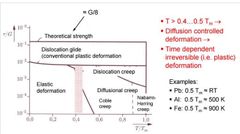
|
Ashby Map |
|
|
What is Diffusion creep? |
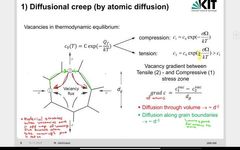
- Deformation by the diffusion of vacancies through the lattice structure - Requires bonds to break and form -> Energy -> greater at higher Temp - Stable when evenly distributed -> no concentration gradient - explained by Fick's law -> J = - D (delta C)/(delta x) - And that's why the vacancies diffuse - When mechanical stress applied: new vacancies created at the side perpendicular to the direction of the lowest principal stress - vacancies start moving in direction of the crystal planes perpendicular to maximal stress (according to Fick's law - to reach even distribution) - Vacancies either move through crystal (Grain) (Volume Diffusion)= Nabarro-Herring Creep - Vacancies move along Grain boundaries = Coble Creep
Less stress needed than Dislocation creep |
|
|
|
What is Dislocation Creep? |

- Deformation involving the movement of dislocations through a crystal lattice - every time disl. moves through crystal, part of crystal shifts by one lattice point along a plane - the plane that separates the shifted and unshifted part is called the slip plane. - along slip pane all ionic bonds must be broken (one by one) to allow for this shift - this one by one/step by step process gives us a linear lattice defect (Edge or screw)
- climbing with diffusion of atoms and vacancies, concentrations here depend on particle distance - if no particles, then subgrain boundaries - if no subgrain boundaries, then dislocations effect each other - back stress |
|
|
|
Nabarro-Herring vs Coble Creep |
Nabaro-Herring: - Volume diffusion - strain rate ~ 1/d² (p =2) (d = grain sieze) - predominates over high temperature dislocation dependent mechanisms only at low stresses, and then only for fine grained material - increase linearly with stress increasing - increase linearly with Grain boundary size decreasing
Coble Creep - Grain boundary diffusion - strain rate ~ 1/d³ (p=3) (d = grain size) - Lower temp for Coble because activation energy is less for vacancy movement along grain boundary than through lattice |
|
|
|
Dislocation Climb |
- when obstacle (pt defect) gets in the way of a dislocation movement - Vacancies required - When vacancy arrives at place where dislocation is stuck - dislocation can climb out of its glide plan and into another to overcome obstacle - therefore vacancy diffusion dependent (in effect both dislocation creep and diffusion creep are diffusion controlled) |
|
|
|
Power Creep Law and Diffusion and Dislocation creep. What is n? |
- Diffusion: n = 1 -> creep power law tells us then that strain rate depends on stress linearly - Dislocation: n = 3-8 -> creep power law tells us about a different relation between strain rate and stress
|
|
|
|
When T < 0.4*Tm how does dislocation glide look for Ni and W? |
Ni - FCC {111} 4 independent slip planes <110> 3 independent slip directions
W - BCC {110} 6 indep slip planes {112} 12 indep slip planes {321} 24 indep slip planes <111>
For FCC hardly any strength reduction for increasing T For BCC strong strength reduction for increasing T
At low Temp BCC is much stronger
Why? 1. BCC is less densely packed and thus requires more energy to casue a slip. The densest slip plan is less dense than for a FCC structure
FCC has a dense packing system - partial dislocation (only split into 2) - creates Area = Planar stacking Fault which needs a stacking fault energy
BCC - several splitting cases possible (split into 4 partial dislocations) much higher energy required for this dislocation -> higher temperature required for dislocations to move
|
|
|
|
Slip Planes of FCC |
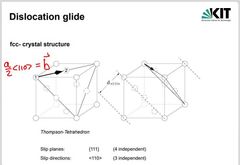
|
|
|
|
BCC slip planes |
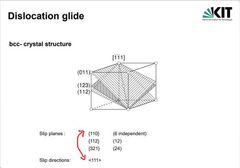
|
|
|
|
Why Does the strength of Ni3Al increase with increasing Temperature? |
YSA (Yield Stress Anomaly) = Strength increases when Temp increases Ni3Al FCC: Al (cube) Ni (Face Centered) = L1_2 {111} slip plane <110> slip direction
1. APB (Antiphase boundary) is a dislocation cheaper to occupy a 'wrong' atom lattice space than to take the path of longer burger vectors to occupy the 'correct' lattice space. APB increases stacking fault energy in system => dislocation hindered
2. Kear Wilsdorf Lock: when Screw dislocations cross slip (partial dislocation from (111) to (010) = immobilisation (LOCK) - first disl slides transversely from (111) to (010) - second disl would unlikely cross slip at exactly same position
This cross slip is thermally activated, and requires a double kink to be formed which also needs energy |
|
|
|
Anti Phase Boundary |
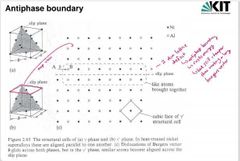
|
|
|
|
YSA (above and below peak) |
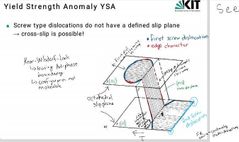
Yield Strength Anomaly
Below peak YSA - octahedral slip: (111) [-101] - strength nearly independent from strain rate - After deformation: long immobile screw dislocations
Above peak YSA - 700 800 900 deg celsius - cube slip: (001) [-101] (exception: [001] orientated crystals) - strength depends on loading rate
-> same b vector but different slip systems
Kear Wilsdorf Lock: Immobilisation of [-110] screw dislocation after cross slip of partial dislocation from (111) -> (010) planes
This cross slip is thermally activated
cross slip requires a double kink -> Kear Wilsdorf Lock (also need high energy to form which means we need an increase in temp)
NB! Only screw dislocations work with this because they do not have a defined slip plane So this Lock makes movement of dislocations more difficult |
|
|
|
Why does the strength of Ni3Al drop again after very high temperatures after it increases at higher temperatures? |
Diffusion sets in and the APB dissolve Energetically cheaper when stacking errors are undone |
|
|
|
Why does FeAl increase in strength with increasing Temperature? |
B2 BCC (Fe - Cube, Al Body centered) YS increases, but only at 400 deg C YSA comes through the vacancies Hardening by thermal vacancies H_formation < H_movement (special case for FeAl) These vacancies cause distortion in the lattice -> hardening |
|
|
|
What happens to FeAl if heated to 700 degrees celsius (lots of vacancies) and then cooled? |
The Vacancies remain in the material since the vacancy transportation energy is very high |
|
|
|
Dislocation Climb |
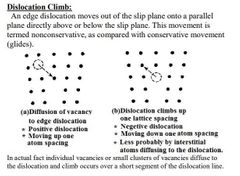
|
|
|
|
What does the stress depend on in creep? |
sigma proprtional to sqrt(rho) = 1/L L = dist between particles or obstacles (dislocation distance - translated)
tau = Gb/L
Obstacles (dislocations) have to be within a Grain Boundary, so L would need to be smaller than Grain Boundaries. For high Temp Grain Boundaries: about 100 um So L = about 10 um rho is the density of obstacles (dislocations - translated) |
|
|
|
Draw a Nickel Stress Strain Curve at RT and HT |

|
|
|
|
What elements do you need for a Nickel Base Super Alloy? |
- Co, Mo, Re, W, Ta for solid solution hardening - Al (Al2O3), Cr (Ni2CrO4) for oxidation resistance (Al for precipitation hardening so Cr used here) - Al and Ti for y' precipitation hardening Attention: y is a mixed crystal, y' is an ordered crystal |
|
|
|
Draw the y and y' phase unit cell |

|
|
|
|
What do you need for a MA6000? |
A Dispersoid such as Y2O3 (yttrium oxide) Dispersoids inhibit recrystallization and Grain growth by pinning grain boundaries during subsequent heat treatments Uncrystallized grain structures provide higher strength |
|
|
|
What is the difference between a presipitate and a Dispersoid? |
Precipitates: - components formed during melting phase - a second phase, typically present in smaller amounts - acts as strong obstacle to slip of dislocations - should be small and high density
Dispersoids: - finely divided particles that can improve recrystallization resistance by pinning GB - insoluble particles - formed during homogenization of large parts by a solid-solution reaction of modest solubility elements with transition metals |
|
|
|
What do you need for precipitation hardening? |
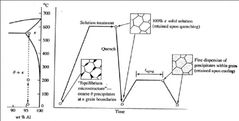
- A supersaturated mixed crystal |
|
|
|
What happens at primary, secondary and tertiary creep |
1. Primary Decreasing strain rate over time - dislocations come from cooling after removed from the melt - increasing dislocation density, or increasing grain size - in ss- hardened materials: decreases because thinning of solute drag
2. Secondary Strain rate constant - Dislocations and GS reached equilibrium - Dislocation Formation = Dislocation Annihilation
3. Tertiary exponentially increases - necking - cracking - voids - all decrease CS area and increase true stress = fracture |
|
|
|
How does cancelling of dislocations work |
If 2 dislocations with opposite signs are on the same sliding plane they cancel each other out |
|
|
|
What is important for dislocation climb and what does it depend on? |
It depends on vacancy diffusion. Because for a climb to take place vacancies need to be present. Diffusion is proportional to the arrhenius equation: D ~ exp(-Q/(RT)) Q = activation energy (Made up of formation and movement enthalpy) |
|
|
|
If I increase Stress but keep T constant that means Diff coeff also remains constant. Why does the creep rate still increase |
Dislocation density is higher
Higher strain rate means more dislocation formation and recovery takes place simultaneously. So the dislocation density is higher = diffusion paths for dislocation climbing are shorter (L is shorter)
sigma ~ spt(rho) |
|
|
|
Draw the Creep Curve for 2 strains. What remains constant. |
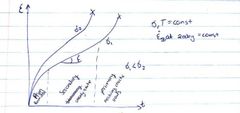
|
|
|
|
What are the contributions to overall deformation |

|
|
|
|
What is the norton plot? |
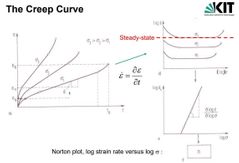
|
|
|
|
Influence on Stress on Vacancies and Strain |
More stress means more vacancies formed means higher strain rate n=1 strain rate ~ Stress |
|
|
|
What does creep rate depend on |
External: Temperature Stress Diffusion of Vacancies Internal: Grain Size SS strengthening Particle strengthening (precipitate) |
|
|
|
Why does Dislocation creep depend on grain size when the grain size is less than 10 um? |
Because then the grain diameter (d) has similar length to average dislocation distance (L) -> less recovery |
|
|
|
How does the creep test work? What do you need? |
An oven (for heating) A Constant load (extension meter) Heat up Temperature of oven and sample. Then apply the constant stress and measure the change in length of the Sample through the LVDT |
|
|
|
What does high temperature mean at what is significant about it? |
0.4 to 0.5 * Tm Where diffusion plays a role |
|
|
|
Explain the constant load on the sample |
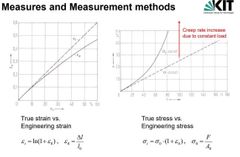
Stress does not remain constant because the cross section changes. That is why we use true stress |
|
|
|
How are dislocations formed |
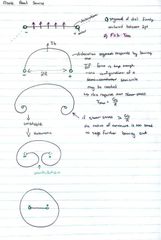
Frank Reed Source: -mechanism explaining generation of multiple dislocations in specific well spaced slip planes in the crystals when they are deformed - When a crystal is deformed, in order for a slip to occur, dislocations must be generated in the material - cold working increases the number of dislocation by Frank Reed Mechanism
|
|
|
|
Orowan |
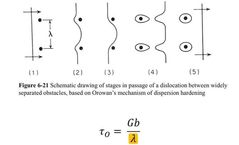
strain rate = b*rho*v |
|
|
|
How Can you determine the volume fraction of the present phases in a material? |
Lever Rule or Calculate from SEM or TEM images |
|
|
|
What is the difference between AlCu and Ni Superalloys in terms of precipitates? |

AlCu Precipitate percentage very small < 10% in AlCu NiAl Precipitate a very high percentage - lever rule says even above 50%
|
|
|
|
How does Yield Strength of Ni3Al and Ni-crystal depend on Temperature? Why? |
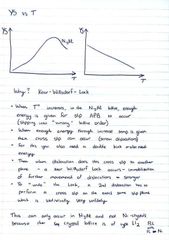
|
|
|
|
At lower temperatures dislocations are much more prevalent in an Ni-Crystal than in Ni3Al. Why? |
At lower temperatures there is not enough energy for the APB to occur in the Ni3Al crystal structure. And the burger vector from Al to Al lattice site is too far and thus requires far to much energy. Ni crystal is much softer and dislocations can form with less activation energy. |
|
|
|
What is important for dislocation climbing? |
Vacancies present and an external stress |
|
|
|
What is crucial for diffusion creep? |
GB size Activation of Vacancies (Diffusion Coefficient) D = D_o * exp(-Q/(RT)) Graph: increasing straight line for log(D) vs T |
|
|
|
How can the Diffusion rate be influenced |
- Temperature Obviously - D_o can be influenced by lattice structure (packing density - BCC open better for Diffusion, FCC close packed) - can also be influenced by enthalpy of formation and migration |
|
|
|
Is enthalpy formation or migration usually higher and where is the exception? |
Normally: H_vac,formation > H_vac,migration Exception: FeAl => relatively stable vacancies - Once vacancies form at higher temperatures they remain in the crystal when cooled = SS strengthening effect |
|
|
|
Why is diffusion creep relatively difficult to measure? |
Test must be carried out at high temp and for a long time. -> structural change, coarsening = no stationary creep rate value Grain Coarsening happens when recrystallization and recovery have occurred and then the only way now to minimize energy is by reducing the total length of the grain boundaries thereby increasing grain size = coarsening |
|
|
|
What are Ni-base super alloys? And how are they formed? |

2 phase alloys. Ni3Al (y') precipitate in Ni-crystal (y) structure Quite a high percentage of the precipitate > 50 % 1) Solution Annealing 2) Quenching 3) Age hardening at elevated temperature |
|
|
|
Which phase in the Ni-Al phase diagram is interesting at high temperatures? What are the advantages? And what is the Structure? |
NiAl - Structured BCC B2 Advantages - Tm = 1638 deg C - low density = 5.9 g/cm³ - high thermal conductivity - good oxidation resistance Disadvantage - Low RT ductility - Low fracture toughness - low creep resistance (best solution is adding Mo through fibres 2nd best is particle strengthening) |
|
|
|
Draw the precipitate in the Ni solution |

|
|
|
|
Why is there good oxidation resistance of NiAl? And what other protection layers are possible? |
Al2O3 forms on the surface Chromium Oxide and Silicon Oxide |
|
|
|
How would a creep curve look like if there are small Grains and no dislocations |
primary region left out |
|
|
|
How do the dislocations behave in an y/y' super alloy? |
Dislocations form in y-matrix. Path limited by y' When enough energy given = cutting into y' APB must be created because of the L1_2 structure |
|

